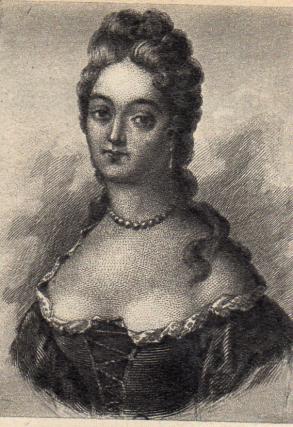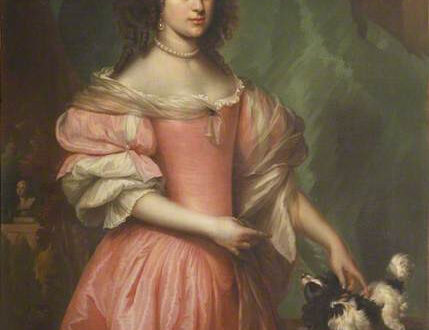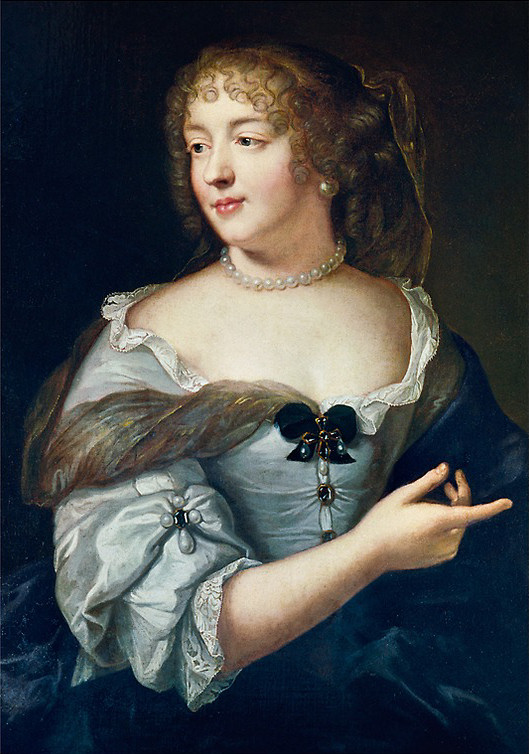Marthe-Marguerite Le Valois de Villette, Marquise de Caylus
Madame de Caylus was one of the grand dames of Versailles and famous for her writings. She was born on 17 April 1671 or 1673 to Philippe Le Valois de Villette de Mursay and Marie-Anne de Chateauneuf at the château de Mursay, a estate that once belonged to Agrippa d’Aubigné. This Agrippa d’Aubigné, a famous companion of Henri IV, was her great-grandfather and the name d’Aubigné might ring some bells.
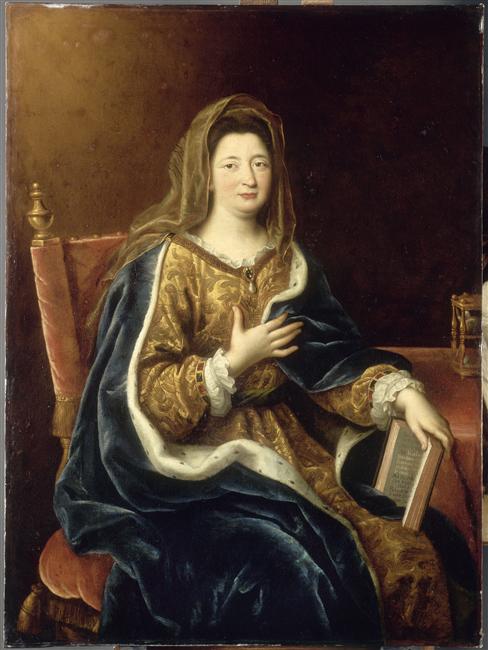
Agrippa’s son, Constant d’Aubigné, was the father of a certain Françoise d’Aubigné, better known as Madame de Maintenon. Agrippa’s daughter, Louise-Arthemise d’Aubigné, known as Madame de Villette, was the grandmother of the future Madame de Caylus and took care of Madame de Maintenon as she was a child. Françoise and Madame de Villette got along very well, but she was removed from her care, on behest of her Catholic godmother, because it was feared Madame de Villette’s Protestant ideas were not too good for Françoise.
Marthe and her three siblings were brought up as Protestants. By the time of Marthe’s birth, Françoise d’Aubigné as was steadfast Catholic widow, who had just been employed by Madame de Montespan and Louis XIV to look after their offspring. A couple of years later, Françoise d’Aubigné became the Marquise de Maintenon and slowly but surely found her way into the King’s heart. By 1680, the Marquise, not having children herself, decided to take care of her Protestant nieces and nephews… in order to bring them up as good Catholics.
Thus she arranged for Marthe, then known as Mademoiselle de Mursay, to leave the loving arms of her family. The girl was taken away from them and brought to Saint-Germain. Her father was quite outraged, her mother thought it might be for the best, since it appeared that Louis XIV was no longer inclined to be friendly towards Protestants.
In her work Souvenirs, Marthe describes the experience as follows: “At first I cried a good deal, but the next day I found the King’s Mass so beautiful that I consented to become a Catholic on condition that I should hear it every day and that no one should whip me. That is all the controversy that was employed and the only abjuration that I made.”
Madame de Maintenon also arranged for Mademoiselle de Mursay to receive a court-worthy education: “I was brought up with a care for which Madame de Maintenon cannot be too much praised. Nothing happened at court without her causing me to make such reflections on it as I was capable of, approving me when I thought justly, and correcting me when I thought badly. My days were spent among masters, reading, and honest and well-regulated amusements, my memory was cultivated by obliging me to learn verses by heart, and as I was under the necessity of giving an account of my reading or any sermon I heard, I was forced to pay attention. In addition to this I had to write a letter every day either to a member of my family or some other person whom I might choose, and this I had to take to Madame de Maintenon every evening that she might either approve or correct it, according as it was well or ill done.”
As Mademoiselle de Mursay was in her early teens, plenty gentlemen at court already found her quite charming and spoke to Madame de Maintenon regarding a possible marriage. (Maybe not just because of Mademoiselle’s charming personality, but also the fact that la Maintenon had become the wife of Louis XIV in the meanwhile.) Among the admirers were persons of great quality and standing… but the Marquise refused all offers for her niece, saying she is not a good enough match for the gentlemen. In the end, Madame de Maintenon picked the groom herself. It was not someone with great standing, money, or good prospects like the other gentlemen, who offered marriage.
The chosen groom was Aimé-Jean-Anne de Tubière de Grimoard de Pestels de Caylus, called Anne, devoid of merits, but in possession of a few drops of Bourbon blood. The marriage took place on Versailles on 14 March in 1686 and the bride received a pearl collar worth 10.000 écus and a moderate yearly pension from the King. The couple moved into an equally moderate apartment at Versailles.
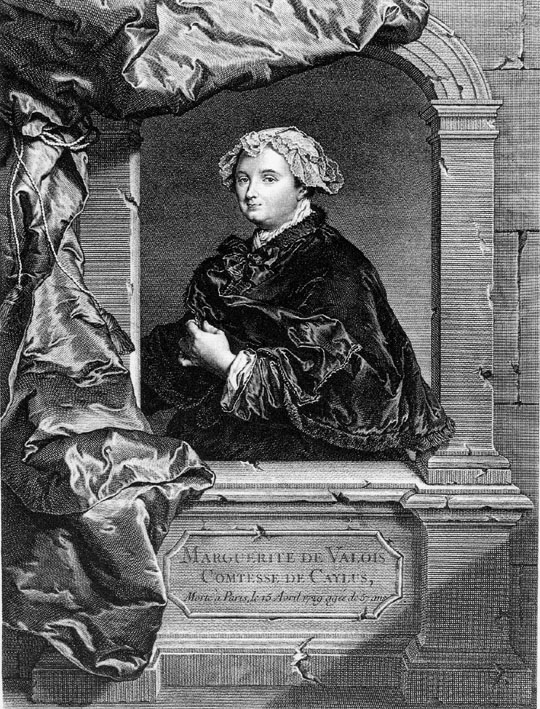
If the Sun King hadn’t been talked out of pursuing carnal pleasures by then, the new Marquise de Caylus surely would have been on his list of conquests. She was smart and witty, very beautiful and well-spoken, charming and a bit timid, modest and absolutely agreeable. Saint-Simon, who does not praise too often, said: “Never was there a visage so intelligent, so affecting, never such grace and wit, never such gaiety and amusement, never was a creature more attractive.” The Abbé de Choisy agrees: “Mirth and laughter beamed around her, her mind was still more amiable than her visage,… and if her natural gaiety had permitted her to retrench certain little airs rather too coquettish, which all her innocence could not justify, she would have been a perfect person.”
The Marquise de Caylus was involved in the scandal around Racine’s play Esther and the girls school of Saint-Cyr. Madame de Maintenon had founded the school and in contrary to normal convent schools for girls, Saint-Cyr also had acting on the schedule. The girls studied and performed the great tragedies brilliantly, but Madame de Maintenon did not enjoy it too much, for she though the girls put too much fervour into it… especially into the romantic love scenes. Thus she asked the great Racine to write something a little more fitting for her girls. Madame de Caylus was not planned to take part in the play at first, but she impressed Racine and her aunt by reciting parts of it with so much grace and emotion, that Racine added a prologue especially for her to recite.
It turned out to be a good decision. As the play celebrated its premier on 26 January in 1689, everyone was utterly taken by it. Madame de Caylus’ prologue was especially well delivered and received, and she showed so much talent that she was promoted to perform the role of Esther during the next performances. Esther received so much praise, that soon voices, those of men of the Church, grew louder and louder. Saying that the girls should learn to be good and pious wives and not actresses that bathe in applause. All of this would make them way too vain and proud, it would distract them from what is important, namely God and prayers. Madame de Maintenon feared the same… and so, plays were no longer performed at Saint-Cyr.
Madame de Caylus, who had been celebrated on the stage, returned to the usual boredom of court-life and sought to make it a little bit more interesting. She was not yet twenty years old, lively and had the habit to wittily say what she thought and do what she wanted. Many of the older courtiers took a bit of an issue with it. The world was too interesting for Marthe to solely focus on prayers and sermons…. but the older the King grew, the more convent-like became the court thanks to Madame de Maintenon. It was not really a place for young girls to have fun. The Marquis de Caylus was hardly ever-present to provide distraction either. He was too busy with campaigns for the King’s glory.
Marthe sought distraction elsewhere and became friends with Madame de Bourbon. They were roughly of the same age and the Duchesse was known to be a merry creature, like her mother Madame de Montespan. Madame de Caylus joined her clique and played tricks on the courtiers together with the Duchesse. Marthe also had a bit of an affair going on with the Duc de Villeroy, which caused quite the fuss at court. She grew very fond of gossiping and started to scoff quite a bit about how boring court-life had become. Many, also of the older generations, shared that feeling… but they did not dare to say it out loud. Madame de Caylus did: “This place is so dull that it is like an exile to live here!”
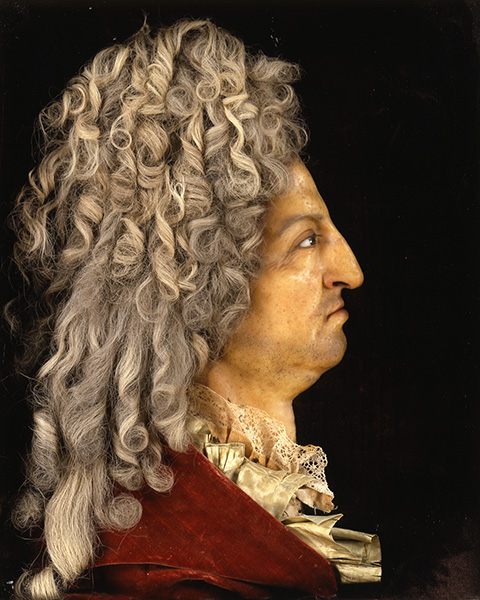
That was enough for Louis XIV. He found Marthe’s new attitude rather bothersome and took her by her word. If it is so boring at court, she ought to stay away and live elsewhere, he said. The whole think also reflected badly on Madame de Maintenon, for she was the one who brought the girl to Versailles and she was the one who provided the girl with an education. Now that girl had become a cheeky nuisance.
Thus Marthe had to leave court. Madame de Maintenon distanced herself from her niece, which in turn meant that this disgrace would last for a while… and that it did. Madame de Caylus was not allowed to return until thirteen years later, after she had proved to Madame de Maintenon that she was now sufficiently modest, pious and submissive enough again.
The Marquise returned to court on 10 February 1707 and was present for the King’s supper. He welcomed her, but not with much joy. By that time, Marthe was widowed for around two years already. She was in her early thirties, “beautiful as an angel” and just as graceful. Marthe didn’t lose her charm during her absence and once she was back, she swiftly regained the favour of her aunt again. They even grew closer than they were before. Madame de Caylus had no plans to marry again, she was more interested in intellectual matters than men. She remained at court until the death of the great Sun King, after which Madame de Maintenon retired to Saint-Cyr and Madame de Caylus to Paris.
A small house next to the Luxembourg gardens became her new home and her salon a centre of intellectual exchange. She hosted big suppers for all the smart men and women that flocked to her house everyday and entertained them with anecdotes of days past. Her guests found her stories so good and well delivered, that they urged her to write them down, not for the general public, but for them to read. Madame de Caylus had a natural talent to make things interesting, they thought.
She sat down and wrote these stories and portraits of people she knew down, under the title of Souvenirs, for her friends and whoever else wanted to read it. All spontaneous and witty. Her Souvenirs remained in manuscript form for long years, until 1770 after they had been edited by Voltaire.
Marte died in Paris in 1729, aged fifty-six, ten years after her aunt Madame de Maintenon.


